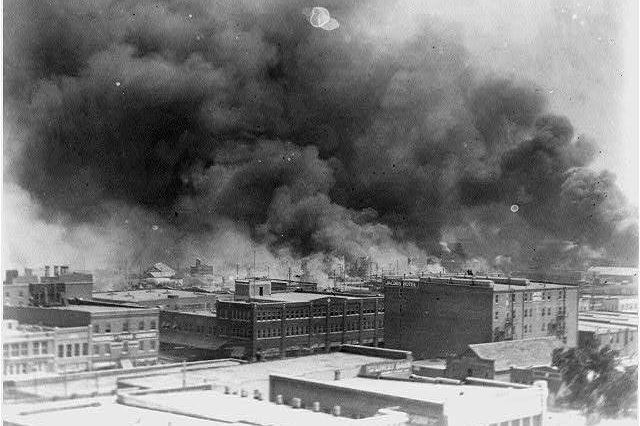1 of 3 | Smoke is shown billowing over burning buildings in the predominantly Black Greenwood section of Tulsa, Okla., on June 1, 1921, during the Tulsa Race Massacre, when a white mob attacked the neighborhood. As many as 300 people were killed during the riots. Photo courtesy Library of Congress
Jan. 11 (UPI) — The Justice Department has issued a report on its exhaustive probe of the 1921 Tulsa Race Massacre in which it concludes that while there is no longer any “avenue of prosecution,” its findings provide a needed historic record of the tragedy.
The report, released Friday, documents the DOJ’s findings made during its review and evaluation of the massacre, which it undertook under the Emmett Till Unsolved Civil Rights Crimes Act.
It examines the events of May 31 and June 1, 1921, when the uniquely prosperous Black community of Greenwood in Tulsa was subjected to a violent attack by as many as 10,000 white Tulsans — an assault “so systematic and coordinated that it transcended mere mob violence,” the DOJ said.
As many as 300 people were killed and 1,200 homes, businesses, schools and churches destroyed in the deadly attack.
“The Tulsa Race Massacre stands out as a civil rights crime unique in its magnitude, barbarity, racist hostility and its utter annihilation of a thriving Black community,” Assistant Attorney General Kristen Clarke of the Justice Department’s Civil Rights Division said in a statement.
“In 1921, white Tulsans murdered hundreds of residents of Greenwood, burned their homes and churches, looted their belongings, and locked the survivors in internment camps.
“Until this day, the Justice Department has not spoken publicly about this race massacre or officially accounted for the horrific events that transpired in Tulsa. This report breaks that silence by rigorous examination and a full accounting of one of the darkest episodes of our nation’s past,” Clarke said.
The investigation has unearthed new information showing the massacre was the result not of uncontrolled mob violence, “but of a coordinated, military-style attack on Greenwood.”
The review found that the trigger for the violence was an allegation by a white man against Dick Rowland, a 19-year-old Black man, who was accused of assaulting a white woman who operated an elevator Rowland had used.
After Rowland’s arrest, a local newspaper “sensationalized the story,” and shortly afterwards a mob of white Tulsans gathered outside the courthouse, demanding a lynching. After Black men from Greenwood were called in the by sheriff to protect the jail, the white mob grew more agitated.
The Tulsa police force deputized hundreds of white residents, many of whom had been drinking and agitating for Rowland’s murder, then helped organize these special deputies into the forces that would eventually ravage the Greenwood community, according to the report.
The next morning, the organized cadres of white men “looted, burned and destroyed 35 city blocks” while Greenwood’s residents tried desperately to defend their homes. As they fled for their lives, white residents chased them across the city and took men, women, children, the elderly and the infirm into custody, looting the homes they left behind, the report found.
In the aftermath of the massacre, the few avenues for federal prosecution that were available at the time were not pursued. And now, 113 years later, the statute of limitations has expired for all federal civil rights offenses, prosecutors noted.
The DOJ team said it could find no living perpetrators or live witnesses with sufficient knowledge of the events to prove a defendant’s guilt beyond a reasonable doubt — thus foreclosing any legal action today.
However, the review “recognizes and documents the horrible events that occurred as well as the trauma and loss suffered by the residents of Greenwood,” the DOJ said.
“While legal and practical limitations prevent the perpetrators of the crimes committed in 1921 from being held criminally accountable in a court of law, the historical reckoning continues.” prosecutors said. “Legal limitations may have stymied the pursuit of justice, but work continues to ensure that future generations understand the scale and significance of this atrocity.”
